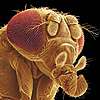Eye of a fruit fly

(Medical Xpress) -- A tiny fruit fly's retina may hold the key to understanding the cause of the progression of Alzheimer's disease, according to a newly published study by researchers at the University of Dayton and the University of Florida.
Amit Singh, assistant professor of biology, worked with University of Dayton collaborator Madhuri Kango-Singh, pre-med students, graduate students and researchers at the University of Florida to investigate early detection of Alzheimer's, an incurable disease that afflicts an estimated 5.4 million Americans.
Using the fruit fly's eye as a model, the research team discovered that memory loss can likely be prevented by blocking the death of cells through the manipulation of a key gene. Their research is published in PLoS ONE, an international, peer-reviewed online journal.
Scientists believe that Alzheimer's is caused by a mutation in a gene that creates protein deposits in the brain called amyloid plaques. If these plaques can be reduced, the loss of memory can be stemmed.
The research team used fruit flies because human amyloid-beta protein, which is responsible for amyloid plaques, is produced at higher levels only in the eyes of these flies. Researchers can study and analyze the effects of amyloid plaques over a longer period of time as the blind flies do not have serious mortality issues, according to Singh.
In the lab, Singh and his team of student researchers accelerated the growth of amyloid plaques in fruit flies to understand what's happening at the gene level — and to test ways to block the genetic pathways that lead to Alzheimer's disease.
They discovered that a stress-activated protein contributes to cell death, and that its pathway can be blocked. They're now collaborating with University of Dayton biologist Panagiotis A. Tsonis in testing 3,000 different drugs on the fruit flies to find candidates for stopping the death of neuronal cells in the fly eye.
"Alzheimer's is often detected very late, once the damage has been done. Scientists are looking into early detection, before you start seeing signs of cognitive decline," Singh said.
Singh calls the common fruit fly "the Cinderella of modern genetics" because it has similar genetic traits as humans. His lab in the Center for Tissue Regeneration and Engineering at Dayton (TREND) contains 1,500 strains of fruit flies.
Under a National Institutes of Health grant, he's also studying the genetics of fruit flies in an effort to gain a greater understanding of how birth defects happen in eyes. He's using the $218,250 two-year grant to "help unravel the genetic underpinnings" that are responsible for pediatric blindness, retinal diseases and other eye defects.














